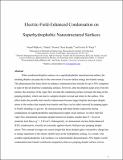Electric-Field-Enhanced Condensation on Superhydrophobic Nanostructured Surfaces
Author(s)
Miljkovic, Nenad; Enright, Ryan; Wang, Evelyn N.; Preston, Daniel John
DownloadMain article, figures, and supplementary information (3.411Mb)
PUBLISHER_POLICY
Publisher Policy
Article is made available in accordance with the publisher's policy and may be subject to US copyright law. Please refer to the publisher's site for terms of use.
Terms of use
Metadata
Show full item recordAbstract
When condensed droplets coalesce on a superhydrophobic nanostructured surface, the resulting droplet can jump due to the conversion of excess surface energy into kinetic energy. This phenomenon has been shown to enhance condensation heat transfer by up to 30% compared to state-of-the-art dropwise condensing surfaces. However, after the droplets jump away from the surface, the existence of the vapor flow toward the condensing surface increases the drag on the jumping droplets, which can lead to complete droplet reversal and return to the surface. This effect limits the possible heat transfer enhancement because larger droplets form upon droplet return to the surface, which impedes heat transfer until they can be either removed by jumping again or finally shedding via gravity. By characterizing individual droplet trajectories during condensation on superhydrophobic nanostructured copper oxide (CuO) surfaces, we show that this vapor flow entrainment dominates droplet motion for droplets smaller than R ≈ 30 μm at moderate heat fluxes (q″ > 2 W/cm2). Subsequently, we demonstrate electric-field-enhanced condensation, whereby an externally applied electric field prevents jumping droplet return. This concept leverages our recent insight that these droplets gain a net positive charge due to charge separation of the electric double layer at the hydrophobic coating. As a result, with scalable superhydrophobic CuO surfaces, we experimentally demonstrated a 50% higher overall condensation heat transfer coefficient compared to that on a jumping-droplet surface with no applied field for low supersaturations (<1.12). This work not only shows significant condensation heat transfer enhancement but also offers avenues for improving the performance of self-cleaning and anti-icing surfaces as well as thermal diodes.
Date issued
2013-11Department
Massachusetts Institute of Technology. Department of Mechanical EngineeringJournal
ACS Nano
Publisher
American Chemical Society (ACS)
Citation
Miljkovic, Nenad, Daniel J. Preston, Ryan Enright, and Evelyn N. Wang. “Electric-Field-Enhanced Condensation on Superhydrophobic Nanostructured Surfaces.” ACS Nano 7, no. 12 (December 23, 2013): 11043–11054.
Version: Author's final manuscript
ISSN
1936-0851
1936-086X